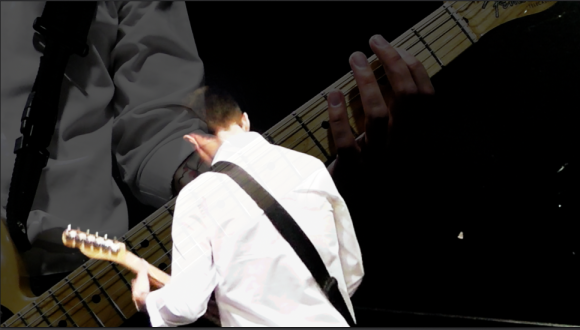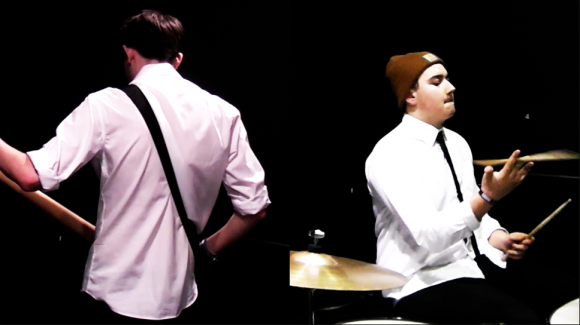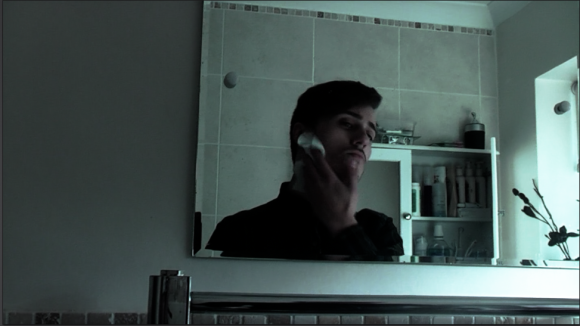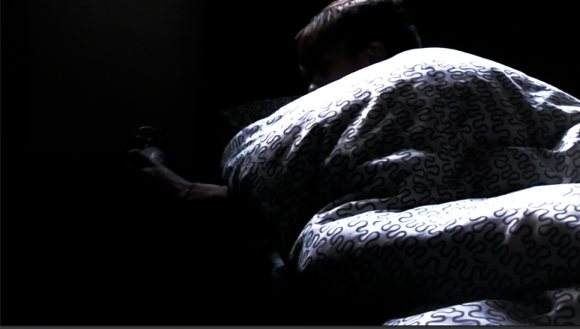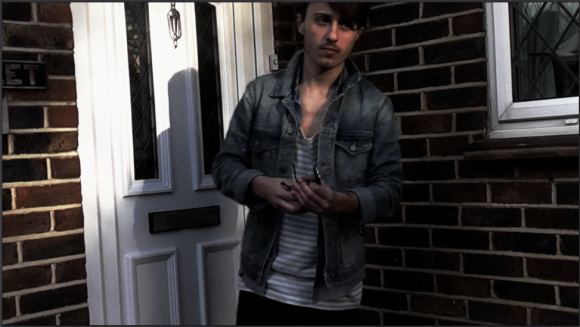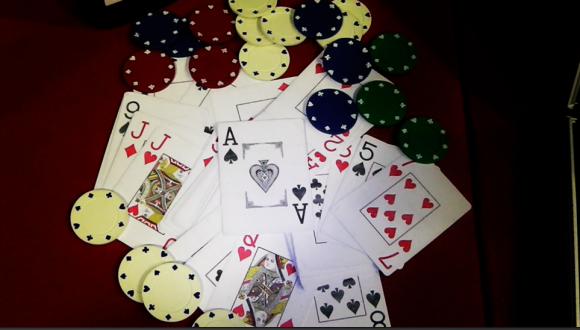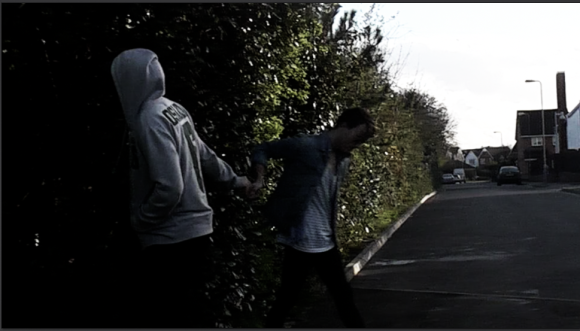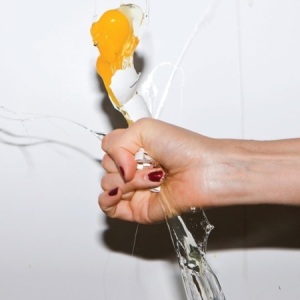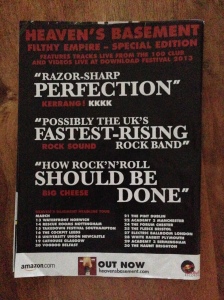Music Video:
My video begins with a shot of myself playing guitar. The shot is a mid POV shot, with an extreme close-up of the guitar riff being played faded over the top, it already begins with a post modern aspect as we see the image from two different perspectives. The costume this person is wearing challenges the stereotype of a ‘rock star’ – this links to Angela McRobbie theory that men and women are represented through stereotypes. As a connotation of ‘rock stars’ we expect them too look messy, sunglasses, ragged ripped clothes etc.; I decided to link the poker sequences together with the band, and dressed them in smart attire. This convention is again then challenged as you see the tattoos on my arm, this adds to the juxtaposition.
We then see the next two members of the band, in a split screen edit. The bassist on the left hand side of the screen is again turned around, so we see his back adding to the post modern feel. The costumes are again smart, but are again challenged as the drummer is wearing a hat with a smart shirt and tie. The editing process in postproduction was very important here, as I had to sync the instruments to the audio, making the video illustrative.
The narrative then comes into affect and there is a balance of shots between narrative and band performance. The lighting was key to this, as I wanted to portray a dark life inside of his home, in comparison to the brighter light outside which I will later get to. The technicality of the shots is also important, as I wanted to cover a range of shots from different angles and positions; this follows the traditional convention for the camera never in the same place in a music video.
The next few shots of the protagonist, is where we see him through the reflection of the mirror. This again adds to the post modern aspect of we are watching them – which is also in Goodwin’s theory that the audiences are played in a position of a voyeur. What the protagonist is doing in the mirror is key though, as he is grooming himself using props that are products and cleaning wipes which shows he is looking after himself. This challenges the stereotype of a ‘rock star’ again as well as avoiding the convention of a traditional male and cancelling McRobbies theory that male characters are represented through stereotypes. It also shows the boundaries that are now stretched in today’s society meaning that it is tackling social problems.
The next shot of the protagonist is where he is stepping outside into the daylight. I have already mentioned that I wanted the inside of the house to be dark so in comparison to stepping out side it is almost another world. What is key here though is what he is wearing because this is the traditional stereotype of a ‘rock star’ that we were searching for with the vest, denim and aviator sunglasses (significant of Slash from Guns N Roses) this shows that this convention is then followed but not in the most obvious way. The roles are juxtaposed. The use of the iPhone shows technology being used which is also another social topic.
The next point I wanted to make was the difference between amplified, illustrated or disjunctive music videos. Amplified is where a message or lyrics is repeatedly used to portray a message, disjunctive is where the video has nothing to do with lyrics and illustrative is where there is a direct link to the lyrics of the song and the visuals we see.
In the edit of this point we see the entrance of the poker sequences. This is a niche topic and isn’t hugely represented in music videos. It adds to the dynamics of the video giving it equilibrium, which is Todorovs theory. The costumes that we see of the characters here is extremely varied and has a disequilibrium feel to it. There are 3 characters that are all wearing different types of clothing, and are all wearing masks. I decided to do this to make it feel seedy, like you should be covering your identity, yet the 4th character – who is the protagonist – doesn’t conceal his identify as he doesn’t care.
My music video is mainly illustrative which is key in a segment of band performance in the chorus where the lyrics are: “the hand you’ve been dealt” where we see a poker dealer dealing cards, and “the ace of spades leads to the grave” (where we see the image of the ace of spades card used on the Digipak cover and magazine advert, showing the convergence between the product and the synergy of my project) this links to the showing of the bullet multiple times later on in the video. The speed of the edit is also important as it follows the tempo of the music, which is covered in Goodwin’s theory.
I do believe that my music video challenges this view that it is only one of those, as it is mainly illustrative but I also believe that is amplified as well, as we repeatedly show the use of drugs and alcohol along with the mention of leading to the grave, trying to portray a message and directly influence the audience – which is the hypodermic needle theory.
The use of the drugs could be considered niche and to be challenging the conventions, as the use and taking of the drug is never normally shown. In one of my earlier edits I had more short clips of the cutting up of the fake drug and the taking of it, but I decided that simply the lowering down was enough for the consumer to understand what is going on. I think the Blumler and Katz theory is effective here as the audience will watch this as an escape, they can see that this character is at a low and they can compare their lives to what the protagonist is going through.
The drug deal is an important moment as the character that is ‘dealing’ the drugs is portrayed in a convention and stereotype that you would expect. I believe it is the only character that is portrayed in the exact way that you would expect to see them. It also tackles another social issue. It is challenged however that it is shown to be such an easy ordinary thing to ‘deal’ drugs.
As I have mentioned earlier this is a illustrative video, so I relied heavily on my techniques in post production to link the lips with the words we hear, it tells the story more if we see someone speaking it rather than just hearing it. This develops the convention as we only show the odd phrase or word, and even show the singer on the parts where he is not singing and he moves away from the microphone. It is also important, as the “Star Image” needs to be portrayed. This is the same during the guitar solo.
The next segment relies heavily on Angela McRobbies theory that men are portrayed through stereotypes; it is where the two characters start fighting. It was done through a choreographed routine of movements, and a range of shots that would implement trick photography. The fight challenges the convention because it is very even (equilibrium) and is blow for blow, until the closing ‘punch’.
I decided to use post production techniques to show the message that this is a dream by changing the colour of the shots towards the end at the run over scene, and it closes to the fact this is a dream and it was all in his head, and reinforces the hypodermic needle theory. This challenges the traditional stereotype as you don’t truly know what is going on until the last second, in comparison to other music videos where you know what is going on at all points.
Ancillary Task – Digipak:
I am going to go through each section of my Digipak and analyse the creation and the conventions of each segment.
Front Cover:
There aren’t many official conventions that go into the creation of a Digipak main cover, as there are is an infinite number of possibilities and combinations of things that could be included or incorporated into the cover.
The main image of the Digipak can rely solely on photography of a specific object(s) – this can be a representation of the band, or of the lyrics or to portray a message. An example being: Heavens Basement – Filthy Empire, which has a sole image of a burning cigarette. This can be a Connotation of a ‘filthy empire’ as well as being a stereotype of rock music and rock culture. It is a striking image that encapsulates the feel of the album as well as drawing the audience’s eye. Other albums rely on computer generated images and images that are graphically designed.
When talking about the genre of Pop music, you would expect the convention to be that the main image will be of the person. This links to Goodwin’s theory portraying the ‘Star Image’ and in some cases the voyeurism of women and Laura Mulveys theory that women are objectified in the media (an example being: Katy Perry – Teenage Dream). This method directly sells the artist to the consumer.
I used the method of photography – using a shot from the filming process – to directly illustrate the lyrics and theme of the song. I adjusted the colouring of the image and this challenged the convention of my genre (Rock) as all the covers and artwork are very dark and ominous. I made the tone lighter, and I used the colour scheme to show my convergence of advertisement. It juxtaposes and plays with the idea of poker, as a connotation of poker, would be that its played in a dark room at night time, and in my image I have portrayed it in a softer light.
I found that another conventions of Digipaks were that the front cover would normally include the band name/and or logo and the title of the album. This is not essential as I found examples for albums that do not include these (an example being: Yeah Yeah Yeah’s – It’s Blitz!) but I felt compelled to include this as it would only work for artists that have commercial success and would not need to include their name to sell the album. For my purpose however the main aim is to sell my product so I followed the convention and put my album title and band name onto the cover.
Back/Spine:
Firstly the main convention will be the track listing and the order of the songs that are on the CD – this I have done. I did challenge it however by using roman numerals instead of the standard numbering
An album will always have a barcode on the back, the use of the barcode, is so that when scanned, the details of the album will be brought up, for example in a shop it will produce the cost.
On the back of a Digipak there will be the legal requirements, these are antipiracy warnings, rights and licensing, and labels. The antipiracy warming is to discourage the consumer to illegally download or share the album, the rights will be who holds the rights to the music, and if it was to be illegally shared whom they would be stealing from. I have included all of this on my digipak cover (back) as I want it to look as authentic as possible, and to follow the convention, so if this was to be sold in a shop it would meet the legal requirements and would ultimately cover us. I also included a record label logo on the back following the conventions of a signed artist (I also did this for the spine)
The main image I used on the back was an image of the band – this follows Goodwin’s theory of the ‘Star Image’. I found that other existing products would use something that relates to the main image on the front of the packaging, but I felt I wanted to use Goodwin’s theory in this instance.
I reused the band name/logo and album title on the side of the album sleeve. A convention that I found album covers to have that I was not able to use, was the albums personal number/code. This is a small number on the side that categorizes the album; I felt it wasn’t needed.
Both the back cover and spine both follow the challenging of the convention because of the colour that I designed all of the faces of the packaging.
Ancillary Task – Magazine Advert:
From my research I found that these were the conventions of what went into a magazine advert:
The main image
- Album artwork
- Artist/Band
The main image I used on this piece was the image that was used for my Digipak front cover, showing that I followed the convention in this case, however in the process of creating the album cover I expanded on this by including both. I created the same colour scheme on the page, to emphasise the synergy and convergence.
Writing:
- Band name and or logo
- Album title
- Reviews
- Web addresses
- Tour dates
- Singles that are included on the album
- Release date
I followed all of these conventions except the tour dates aspect – I felt that this wasn’t essential in the advertising of the album. I felt that I would include all of these things because it makes it easier for the consumer to find out everything they need to know about the album, for example, when tis outs, what It looks like, where they can buy it from and the mention of singles to boost sales as well as giving them an insight into the album. One convention I wanted to consider which I found on an existing advert was the use of twitter using a “hash tag” (#) which is a topic category on the social networking site Twitter, this would have been beneficial as it would bring them into a new world, where fans can interact with each other as well as the band.
The reviews aspect was very important for me as it is a selling point, and it acts as buzz and puff words to the consumer. Some adverts did not have a main image; they instead displayed the reviews of the album (example being: Heavens Basements advert). This then refers to the Hypodermic needle theory for audiences that it directly influences; this influences them to buy it, to listen to the album themselves.
Other things:
- Parental guidance labeling
- Record Label logo
I have already gone into detail upon the use of twitter – but these are two possible conventions, I followed one which was to put the record label logo onto the advert, as it is also another means of retailing and a place where the album can be brought from, I did not follow the second as the song does not contain and explicit language.
